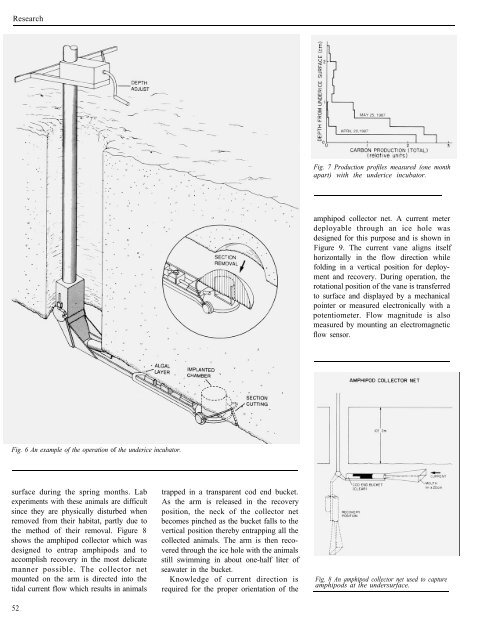SCIENCE REVIEW 1987 - Bedford Institute of Oceanography
SCIENCE REVIEW 1987 - Bedford Institute of Oceanography
SCIENCE REVIEW 1987 - Bedford Institute of Oceanography
You also want an ePaper? Increase the reach of your titles
YUMPU automatically turns print PDFs into web optimized ePapers that Google loves.
Research<br />
Fig. 6 An example <strong>of</strong> the operation <strong>of</strong> the underice incubator.<br />
surface during the spring months. Lab<br />
experiments with these animals are difficult<br />
since they are physically disturbed when<br />
removed from their habitat, partly due to<br />
the method <strong>of</strong> their removal. Figure 8<br />
shows the amphipod collector which was<br />
designed to entrap amphipods and to<br />
accomplish recovery in the most delicate<br />
manner possible. The collector net<br />
mounted on the arm is directed into the<br />
tidal current flow which results in animals<br />
52<br />
trapped in a transparent cod end bucket.<br />
As the arm is released in the recovery<br />
position, the neck <strong>of</strong> the collector net<br />
becomes pinched as the bucket falls to the<br />
vertical position thereby entrapping all the<br />
collected animals. The arm is then recovered<br />
through the ice hole with the animals<br />
still swimming in about one-half liter <strong>of</strong><br />
seawater in the bucket.<br />
Knowledge <strong>of</strong> current direction is<br />
required for the proper orientation <strong>of</strong> the<br />
Fig. 7 Production pr<strong>of</strong>iles measured (one month<br />
apart) with the underice incubator.<br />
amphipod collector net. A current meter<br />
deployable through an ice hole was<br />
designed for this purpose and is shown in<br />
Figure 9. The current vane aligns itself<br />
horizontally in the flow direction while<br />
folding in a vertical position for deployment<br />
and recovery. During operation, the<br />
rotational position <strong>of</strong> the vane is transferred<br />
to surface and displayed by a mechanical<br />
pointer or measured electronically with a<br />
potentiometer. Flow magnitude is also<br />
measured by mounting an electromagnetic<br />
flow sensor.<br />
Fig. 8 An amphipod collector net used to capture<br />
amphipods at the undersurface.



